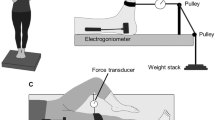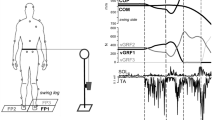Abstract
In research for investigation of static balance performance, postural sway variables have often been normalized by each subject’s height. However, evidence for such normalization has been insufficient. The aim of this study was to investigate the associations of anthropometry with postural sway and their possible gender differences. Forty young subjects (20 men and 20 women) performed quiet standing on a force platform in feet-together stance. Significant gender differences were observed in the correlation of outcome measures with anthropometry. In women, postural balance performance deteriorated (sway size increased and mean stable time reduced) and sway frequencies increased with height and weight. In contrast, men showed insignificant change in balance performance, but a reduction in sway frequency with height and weight. Stepwise multiple regressions revealed that height and weight were the major determinants of outcome measures, and that their effects on outcome measures differed between genders. Extreme care must be taken in normalization of postural sway variables by anthropometric data.
Similar content being viewed by others
References
Aoyagi, K., Ross, P. D., Davis, J. W., Wasnich, R. D., Hayashi, T., and Takemoto, T. I., “Falls among community-dwelling elderly in Japan,” J. Bone Miner Res., Vol. 13, No. 9, pp. 1468–1474, 1998.
Cho, C. Y. and Kamen, G., “Detecting balance deficits in frequent fallers using clinical and quantitative evaluation tools,” J. Am. Geriatr. Soc., Vol. 46, No. 4, pp. 426–430, 1998.
Sattin, R. W., “Falls among older persons: A public health perspective,” Ann. Rev. Public Health, Vol. 13, pp. 489–508, 1992.
Winter, D. A., “Human balance and posture control during standing and walking,” Gait and Posture, Vol. 3, No. 4, pp. 193–214, 1995.
LaPier, T. L. K., Liddle, S., and Bain, C., “A comparison of static and dynamic standing balance in older men versus women,” Physiotherapy Canada, Vol. 2, pp. 207–213, 1997.
Era, P., Sainio, P., Koskinen, S., Haavisto, P., Vaara, M., and Aromaa, A., “Postural Balance in a Random Sample of 7,979 Subjects Aged 30 Years and Over,” Gerontology, Vol. 52, No.4, pp. 204–213, 2006.
Bryant, E. C., Trew, M. E., Bruce, A. M., Kuisma, R. M. E., and Smith, A. W., “Gender differences in balance performance at the time of retirement,” Clin. Biomech., Vol. 20, No. 3, pp. 330–335, 2005.
Era, P., Schroll, M., Ytting, H., Gause-Nilsson, I., Heikkinen, E., and Steen, B., “Postural balance and its sensory-motor correlates in 75-year-old men and women: A cross-national comparative study,” J. Gerontol. A Biol. Sci. Med. Sci., Vol. 51, No. 2, pp. M53–M63, 1996.
Era, P., Heikkinen, E., Gause-Nilsson, I., and Schroll, M., “Postural balance in elderly people: changes over a five-year follow-up and its predictive value for survival,” Aging Clin. Exp. Res., Vol. 14, Suppl. 3, pp. 37–46, 2002.
Kim, J.-W., Eom, G.-M., Kim, C.-S., Kim, D.-H., Lee, J.-H., Park, B. K., and Hong, J., “Sex differences in the postural sway characteristics of young and elderly subjects during quiet natural standing,” Geriatr. Gerontol. Int., Vol. 10, No. 2, pp. 191–198, 2010.
Hue, O., Simoneau, M., Marcotte, J., Berrigan, F., Doré, J., Marceau, P., Marceau, S., Tremblay, A., and Teasdale, N., “Body weight is a strong predictor of postural stability,” Gait and Posture, Vol. 26, No. 1, pp. 32–38, 2007.
Chiari, L., Rocchi, L., and Cappello, A., “Stabilometric parameters are affected by anthropometry and foot placement,” Clin. Biomech., Vol. 17, No. 9–10, pp. 666–677, 2002.
Kitabayashi, T., Demura, S., Yamaji, S., Nakada, M., Noda, M., and Imaoka, K., “Gender differences and relationships between physical parameters on evaluating the center of foot pressure in static standing posture,” Equilib. Res., Vol. 61, No. 1, pp. 16–27, 2002.
Bonnet, C., Carello, C., and Turvey, M. T., “Diabetes and postural stability: Review and hypotheses,” J. Mot. Behav., Vol. 41, No. 2, pp. 172–190, 2009.
Prieto, T. E., Myklebust, J. B., Hoffmann, R. G., Lovett, E. G., and Myklebust, B. M., “Measures of postural steadiness: Differences between healthy young and elderly adults,” IEEE Trans. Biomed. Eng., Vol. 43, No. 9, pp. 956–966, 1996.
Baratto, L., Morasso, P. G., Re, C., and Spada, G., “A new look at posturographic analysis in the clinical context: sway-density versus other parameterization techniques,” Motor control, Vol. 6, No. 3, pp. 246–270, 2002.
Jacono, M., Casadio, M., Morasso, P. G., and Sanguineti, V., “The sway-density curve and the underlying postural stabilization process,” Motor control, Vol. 8, No. 3, pp. 292–311, 2004.
Corbeil, P., Simoneau, M., Rancourt, D., Tremblay, A., and Teasdale, N., “Increased risk for falling associated with obesity: Mathematical modeling of postural control,” IEEE Trans. Neural Syst. Rehabil. Eng., Vol. 9, No. 2, pp. 126–136, 2001.
Jones, K. E., Hamilton, A. F. D. C., and Wolpert, D. M., “Sources of signal-dependent noise during isometric force production,” J. Neurophysiol., Vol. 88, No. 3, pp. 1533–1544, 2002.
Bottaro, A., Casadio, M., Morasso, P. G., and Sanguineti, V., “Body sway during quiet standing: Is it the residual chattering of an intermittent stabilization process?” Hum. Mov. Sci., Vol. 24, No. 4, pp. 588–615, 2005.
Asai, Y., Tasaka, Y., Nomura, K., Nomura, T., Casadio, M., and Morasso, P., “A Model of Postural Control in Quiet Standing: Robust Compensation of Delay-Induced Instability Using Intermittent Activation of Feedback Control,” PLoS ONE, Vol. 4, No. 7, Paper No. e6169, 2009.
Author information
Authors and Affiliations
Corresponding author
Rights and permissions
About this article
Cite this article
Kim, J., Kwon, Y., Kim, J. et al. Gender-differences in the associations of anthropometry with postural sway in feet-together stance. Int. J. Precis. Eng. Manuf. 13, 1897–1902 (2012). https://doi.org/10.1007/s12541-012-0249-2
Received:
Accepted:
Published:
Issue Date:
DOI: https://doi.org/10.1007/s12541-012-0249-2




